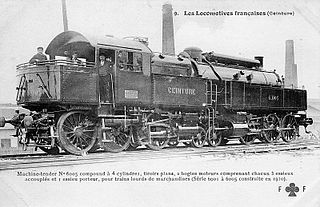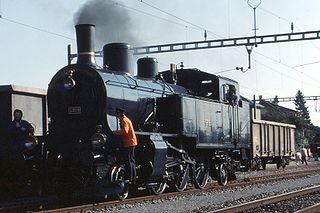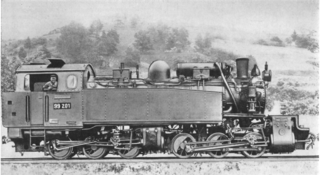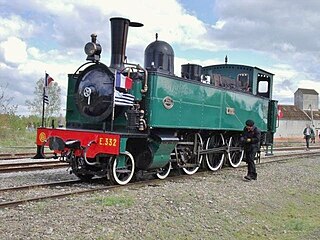Related Research Articles

A Mallet locomotive is a type of compound articulated steam locomotive, invented by the Swiss engineer Anatole Mallet (1837–1919).
The UIC classification of locomotive axle arrangements, sometimes known as the German classification or German system, describes the wheel arrangement of locomotives, multiple units and trams. It is used in much of the world, notable exceptions being the United Kingdom, which uses a slightly simplified form of UIC, and in North America, where the AAR wheel arrangement system is used to describe diesel and electric locomotives. In North America, the Whyte notation is only used for steam locomotives.

A Crampton locomotive is a type of steam locomotive designed by Thomas Russell Crampton and built by various firms from 1846. The main British builders were Tulk and Ley and Robert Stephenson and Company.
Under the Whyte notation for the classification of steam locomotive wheel arrangements, a 2-10-10-2 is a locomotive with two leading wheels, two sets of ten driving wheels, and a pair of trailing wheels.

In the Whyte notation for classifying the wheel arrangement of steam locomotives, an 0-8-8-0 is a locomotive with two sets of eight driving wheels and neither leading wheels nor trailing wheels. Two sets of driving wheels would give far too long a wheelbase to be mounted in a fixed locomotive frame, so all 0-8-8-0s have been articulated locomotives of the Mallet type, whether simple or compound. In the UIC classification, this arrangement would be, refined to Mallet locomotives, (D)D. The type was sometimes called Angus in North America.

In the Whyte notation for the classification of steam locomotive wheel arrangement, a 0-4-4-0 is a locomotive with no leading truck, two sets of four driving wheels, and no trailing truck. Examples of this type were constructed as Shay, Heisler, Climax, Mallet, Meyer, BMAG and Double Fairlie locomotives. A similar configuration was used on some Garratt locomotives, but it is referred to as 0-4-0+0-4-0.

Under the Whyte notation for the classification of steam locomotives, a 4-8-8-2 is a locomotive with four leading wheels, two sets of eight driving wheels, and a two-wheel trailing truck.
In Whyte notation, 2-4-4-2 refers to a railroad steam locomotive that has two leading wheels followed by four coupled driving wheels, a second set of four coupled driving wheels, and two trailing wheels.
Under the Whyte notation for the classification of steam locomotives, a 2-8-8-8-4 has two leading wheels, three sets of eight driving wheels, and four trailing wheels.

A 2-6-8-0 steam locomotive, in the Whyte notation for describing locomotive wheel arrangements, has two leading wheels, a set of six driving wheels, a set of eight driving wheels, and no trailing wheels. These locomotives usually employ the Mallet principle of articulation, with a swinging front engine and a rigidly attached rear engine.

Établissements Billard was a French railway rolling stock construction company founded in 1920 and based in Tours. It specialised in light railbuses and metre gauge and narrow gauge rolling stock. The business ceased trading in 1956 and later became Socofer.

The du Bousquet locomotive was an unusual design of articulated steam locomotive invented by French locomotive designer Gaston du Bousquet. The design was a tank locomotive, carrying all its fuel and water on board the locomotive proper, and a compound locomotive. The boiler and superstructure were supported upon two swivelling trucks, in a manner similar to a Meyer locomotive.

The Tramway de Pithiviers à Toury (TPT) was a 600 mm gauge railway in the Loiret department of France. It was built to carry sugar beet and was 80 kilometres (50 mi) long.

For more than a century, the Swiss locomotive, multiple unit, motor coach and railcar classification system, in either its original or updated forms, has been used to name and classify the rolling stock operated on the railways of Switzerland. It started out as a uniform system for the classification and naming of all rolling stock, powered and unpowered, but had been replaced and amended by the UIC classification of goods wagons.

The Bavarian Class Gts 2x3/3 was a former narrow gauge, German Army, military railway, steam locomotive that was in service on the narrow gauge line from Eichstätt to Kinding.

The Chemin de fer du Vivarais (CFV) - often called Le Mastrou or Train de l'Ardèche - is a tourist railway in the Ardèche region of the South of France. The metre gauge line is 33 kilometres (21 mi) long. The railway is renowned for its historical steam locomotives in Mallet articulated locomotive style, as well as a collection of historic rolling stock and diesel railcars.

The Réseau Breton 4-6-0 tank locomotives were a class of metre gauge locomotives. The twelve class members were built in two batches by Franco-Belge and Fives-Lille for the Réseau Breton (RB) in France. Introduced in 1904, they were to be found all over the Réseau Breton system, lasting in traffic until the closure of the metre gauge lines in 1967.
A 0-6-2+2-6-0, in the Whyte notation for the classification of steam locomotives by wheel arrangement, is an articulated locomotive with two separate engine units with no leading wheels, six powered and coupled driving wheels on three axles, and two trailing wheels. The only examples were forms of the Meyer articulated locomotive.
Under the Whyte notation for the classification of steam locomotive wheel arrangements, a 4-4-6-2 is a locomotive with two pairs of leading wheels, one set of four driving wheels, a second set of six driving wheels, and a pair of trailing wheels.
References
- ↑ Organ, John (2000). "Chapter 3, p3 (unnumbered)". Southern France Narrow Gauge. Midhurst: Middleton Press. ISBN 1-901706-47-8.